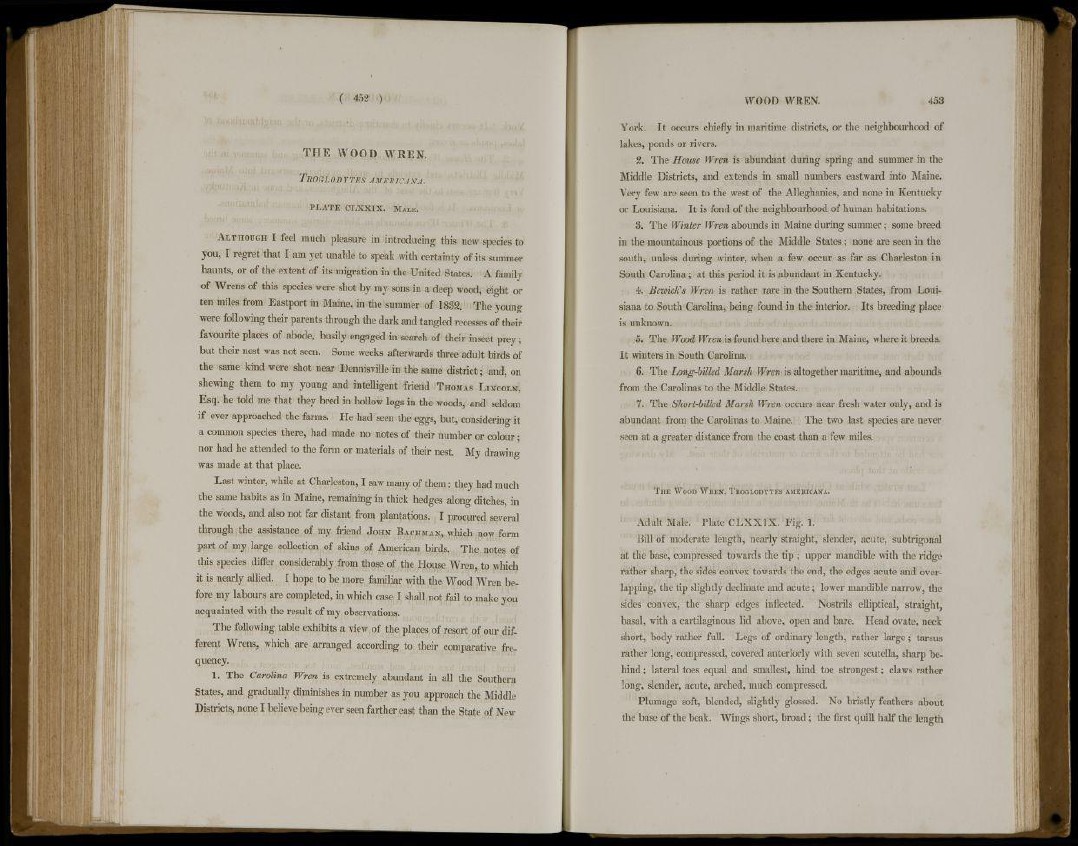
THE WOOD WREN.
TROGLODYTES AMERICANA.
P L A T E C L X X I X . MALK.
ALTHOUGH I feel much pleasure in introducing this new species to
you, I regret that I am yet unable to speak with certainty of its summer
haunts, or of the extent of its migration in the United States. A family
of Wrens of this species were shot by my sons in a deep wood, eight or
ten miles from Eastport in Maine, in the summer of 1832. The young
were following their parents through the dark and tangled recesses of their
favourite places of abode, busily engaged in search of their insect prey;
but their nest was not seen. Some weeks afterwards three adult birds of
the same kind were shot near Dennisville in the same district; and, on
shewing them to my young and intelligent friend THOMAS LINCOLN,
Esq. he told me that they bred in hollow logs in the woods, and seldom
if ever approached the farms. He had seen the eggs, but, considering it
a common species there, had made no notes of their number or colour;
nor had he attended to the form or materials of their nest. My drawing
was made at that place.
Last winter, while at Charleston, I saw many of them: they had much
the same habits as in Maine, remaining in thick hedges along ditches, in
the woods, and also not far distant from plantations. I procured several
through the assistance of my friend JOHN BACH MAN, which now form
part of my large collection of skins of American birds. The notes of
this species differ considerably from those of the House Wren, to which
it is nearly allied. I hope to be more familiar with the Wood Wren before
my labours are completed, in which case I shall not fail to make you
acquainted with the result of my observations.
The following table exhibits a view of the places of resort of our different
Wrens, which are arranged according to their comparative frequency.
1. The Carolina Wren is extremely abundant in all the Southern
States, and gradually diminishes in number as you approach the Middle
Districts, none I believe being ever seen farther east than the State of New
York. It occurs chiefly in maritime districts, or the neighbourhood of
lakes, ponds or rivers.
2. The House Wren is abundant during spring and summer in the
Middle Districts, and extends in small numbers eastward into Maine.
Very few are seen to the west of the Alleghanies, and none in Kentucky
or Louisiana. It is fond of the neighbourhood of human habitations.
3. The Winter Wren abounds in Maine during summer; some breed
in the mountainous portions of the Middle States ; none are seen in the
south, unless during winter, when a few occur as far as Charleston in
South Carolina; at this period it is abundant in Kentucky.
4. Bewick?s Wren is rather rare in the Southern States, from Louisiana
to South Carolina, being found in the interior. Its breeding place
is unknown.
5. The Wood Wren is found here and there in Maine, where it breeds.
It winters in South Carolina.
6. The Long-billed Marsh Wren is altogether maritime, and abounds
from the Carolinas to the Middle States.
7. The Short-billed Marsh Wren occurs near fresh water only, and is
abundant from the Carolinas to Maine. The two last species are never
seen at a greater distance from the coast than a few miles.
THE WOOD WREN, TROGLODYTES AMERICANA.
Adult Male. Plate CLXXIX. Fig. 1.
Bill of moderate length, nearly straight, slender, acute, subtrigonal
at the base, compressed towards the tip ; upper mandible with the ridge
rather sharp, the sides eonvex towards the end, the edges acute and overlapping,
the tip slightly declinate and acute ; lower mandible narrow, the
sides convex, the sharp edges inflected. Nostrils elliptical, straight,
basal, with a cartilaginous lid above, open and bare. Head ovate, neck
short, body rather full. Legs of ordinary length, rather large; tarsus
rather long, compressed, covered anteriorly with seven scutella, sharp behind
; lateral toes equal and smallest, hind toe strongest; claws rather
long, slender, acute, arched, much compressed.
Plumage soft, blended, slightly glossed. No bristly feathers about
the base of the beak. Wings short, broad ; the first quill half the length